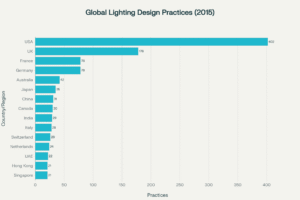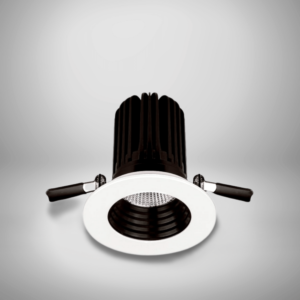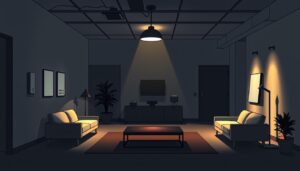Office workers spend over 1,700 hours every year under artificial lighting — so getting it right is crucial. Good lighting doesn’t just let people see what they’re doing; it shapes mood, energy, and productivity across the entire workspace. With updated UK lighting regulations for 2026 and a stronger emphasis on wellbeing, sustainability, and efficiency, it’s time to rethink what “good lighting” really means for modern offices.
This updated guide explains how to meet the latest standards like BS EN 12464‑1, Part L of the Building Regulations, and BS 5266‑1 (2025) — while creating lighting that works beautifully for people and the planet.

Understanding UK Office Lighting Regulations in 2026
Although the UK still doesn’t enforce specific illuminance levels, employers are legally required to provide “suitable and sufficient” lighting under the Health and Safety at Work Act 1974 and Workplace (Health, Safety and Welfare) Regulations 1992. These laws place the responsibility for proper lighting squarely with business owners and facilities managers.
Supporting these legal obligations are technical standards produced by bodies such as the Health and Safety Executive (HSE) and CIBSE (Society of Light and Lighting). Following these ensures you’re not just compliant, but providing a visually comfortable and efficient workspace.
Legal Requirements for Workplace Lighting
UK workplace lighting regulations mandate suitable illumination through the Health and Safety at Work Act 1974 and the Workplace (Health, Safety and Welfare) Regulations 1992.
These laws aim to protect employee well-being, yet they provide minimal specific guidance on defining “suitable lighting”.
Consequently, commercial lighting standards remain deliberately broad and interpretative, leaving employers to navigate lighting requirements with considerable discretionary flexibility.
Key standards and updates for 2026
| Standard | Focus | 2026 Update |
|---|---|---|
| Part L Building Regulations | Energy efficiency | Minimum 95 lm/W for general office lighting and advanced control requirements |
| BS EN 12464‑1: 2021 | Indoor lighting quality | Cylindrical illuminance and context-based illuminance values |
| WELL Building Standard v2 | Human health & wellbeing | Circadian lighting and glare mitigation enhancements |
| BS 5266‑1: 2025 | Emergency lighting | Updated testing and battery performance requirements |
| CIBSE LG7 Code for Lighting | Office lighting design | Integration with hybrid and flexible workspaces |
Navigating Lighting Regulations, Guides, and Standards
- The Health and Safety Executive’s (HSE) HSG 38 guide sets minimum illumination levels.
- The Chartered Institution of Building Services Engineers’ (CIBSE) SLL Code for Lighting provides detailed guidance on illuminance for different tasks and environments.
Staying updated with these regulations, guides, and standards helps you get closer to the right type of lit environment. It ensures compliance and fosters a comfortable, productive work environment.
| Guideline/Standard | Scope/Focus | Key Requirements | Applies To | Latest Version/Notes |
|---|---|---|---|---|
| Part L of the Building Regulations | Energy efficiency of lighting | Minimum energy performance, use of efficient luminaires, controls (e.g., occupancy sensors, daylight sensors), metering | All commercial buildings (new and refurbishments) | England, Wales, Scotland, NI have separate versions; latest updates in 2021/2022 |
| Workplace (Health, Safety and Welfare) Regulations 1992 | General workplace lighting | “Suitable and sufficient” lighting for safety and welfare; includes emergency lighting | All workplaces | UK-wide |
| Health and Safety at Work Act 1974 | General health and safety | Duty to ensure health, safety, and welfare, including adequate lighting | All workplaces | UK-wide |
| HSE HSG 38 Guide | Workplace lighting guidance | Minimum recommended illuminance: 300–500 lux (general office), 500–800 lux (task areas) | Offices, commercial spaces | HSE guidance |
| CIBSE SLL Code for Lighting | Technical lighting guidance | Detailed illuminance levels by task/area, glare control, visual comfort | Offices, commercial spaces | Latest SLL Code |
| BS EN 12464-1 | Indoor workplace lighting | Specifies lighting requirements for indoor workspaces (lux levels, glare, uniformity) | All indoor commercial spaces | 2021 update |
| BS 5266-1:2016 | Emergency lighting | Design, installation, and maintenance of emergency lighting systems | All commercial premises | 2016 version |
| BS EN 1838 | Emergency lighting applications | Specifies requirements for emergency escape lighting and standby lighting | All commercial premises | Current version |
| BS 7671 (IET Wiring Regulations) | Electrical safety | Electrical installation standards, including lighting circuits | All buildings | 18th Edition |
| The Ecodesign for Energy-Related Products and Energy Information (Lighting Products) Regulations 2021 | Product energy efficiency and labelling | Ecodesign and energy labelling for lighting products (UK version of EU SLR/ELR) | All lighting products sold in UK | In force since Oct 2021 |
| RoHS (Restriction of Hazardous Substances) | Environmental safety | Restricts hazardous substances in lighting equipment | All lighting products | UK and EU versions |
| WEEE Regulations | Waste management | Proper disposal and recycling of lighting products | All lighting products | UK-wide |
| Environmental Protection Act 1990 | Light pollution and waste | Minimise light pollution, proper waste management | All businesses | UK-wide |
By adhering to these regulations, guides, and standards, employers can meet legal requirements. This supports the health and productivity of their employees, creating a better workplace.
Why Proper Office Lighting Matters
Simply put, lighting affects everything — from comfort and concentration to health and retention. Studies continue to show that inadequate lighting contributes to eye strain, fatigue, and even disrupted sleep cycles. The HSE’s guide to lighting at work outlines that well‑planned illumination reduces errors, boosts morale, and helps prevent workplace stress.
Impact on Health and Wellbeing
Modern offices must balance artificial illumination with natural daylight. Exposure to light that aligns with human circadian rhythms enhances mood, alertness, and mental health.
Incorporating human‑centric lighting systems — which adjust colour temperature through the day — supports these biological processes and reduces fatigue.
Lighting and Productivity
Workplaces with optimised lighting see improvements in both speed and accuracy. Studies suggest performance increases of up to 12% when lighting is tuned for task type and time of day. Effective lighting boosts focus, reduces absenteeism, and helps staff feel more connected — essential for today’s hybrid office environments.
Designing Effective Office Lighting
Achieving the right illumination involves balancing technical standards with the human experience. From CIBSE lux level guidelines to office ergonomics, every element matters.
Recommended Lux Levels
For 2026, the recommended office lux values remain:
100 lux for corridors and circulation areas
300 lux for general workstations
500 lux for detailed or technical tasks
These values reference BS EN 12464‑1 and CIBSE LG7 best practice.
Minimising Glare and Flicker
The Unified Glare Rating (UGR) should not exceed 19 for offices.
Choose LED luminaires with quality drivers to prevent flicker, and design layouts to minimise reflective glare.
Small changes—like matte workstation surfaces or high‑reflectance ceilings—can dramatically improve workplace comfort.
High quality office lighting is important for employee health, well-being, and productivity. Inadequate lighting can cause eye strain, headaches, fatigue, and musculoskeletal disorders. On the other hand, optimised lighting improves mood, concentration, and work performance.
Impact on Employee Health and Well-being
Optimal office lighting levels are crucial for employee health and safety. Suboptimal lighting can harm the body, including eye strain, headaches, and musculoskeletal issues. It can also disrupt sleep and mental health.
Creating a visually comfortable and ergonomic environment improves employee well-being. It also reduces absenteeism.
Enhancing Productivity and Workflow
Decent office lighting benefits both employee health and productivity. Well-designed lighting enhances concentration, mood, and work quality. It streamlines workflow and increases efficiency.
Optimising office lighting leads to a more conducive environment. This results in increased productivity, reduced absenteeism, and a healthier workforce.
Effective workplace illumination transcends visual appeal, serving as a critical determinant of employee health, engagement, and productivity. Strategic lighting design directly impacts workplace performance, supporting cognitive function, reducing fatigue, and creating an environment that promotes professional well-being.
Factors Influencing Office Lighting Design
Creating effective office lighting requires a detailed approach. The complexity of tasks in various office areas, like administrative work, computer tasks, or precision activities, dictates the lighting requirements based on task. It’s also crucial to consider the workplace layout and lighting, including room size, surface reflectance, and workstation placement. This ensures even lighting, prevents glare, and fosters a visually appealing environment.
Lighting Requirements Based on Task Complexity
The type of work in an office space determines the office lighting design principles needed. For instance, areas for administrative tasks, like paperwork and filing, require higher illuminance for comfort and accuracy. On the other hand, computer-based workstations need lower lighting to reduce glare and eye strain.
To get an idea of how much light you should be aiming for, you can try our free lux level estimator tool.
Workplace Layout and Environment Considerations
Key factors in office lighting design include:
Physical Layout Elements:
- Room dimensions and ceiling height
- Workstation and furniture positioning
- Surface reflectance (walls, floors, ceilings)
Strategic Design Approach:
Optimal office lighting requires a nuanced balance between task-specific illumination requirements and the overall spatial environment. The goal is creating a visually comfortable workspace that supports productivity through intelligent, adaptive lighting solutions.
Critical Considerations:
- Uniform light distribution
- Minimizing glare and shadow
- Accommodating diverse work tasks
- Integrating natural and artificial light sources
Design Objective: Craft a lighting strategy that enhances visual comfort, supports employee performance, and complements the physical workplace infrastructure.
“Effective office lighting design should balance task-specific requirements with the overall workplace layout and environment to create a visually comfortable and productive space.” – Bernadette Pangilinan, Sales Manager
Lighting Guidelines for Offices
To achieve a suitable office lighting setup, adhering to established guidelines is crucial. The Chartered Institution of Building Services Engineers’ (CIBSE) SLL Code for Lighting offers detailed advice. It outlines the recommended illuminance levels for various office tasks and environments.
Recommended Illuminance Levels
Illuminance levels in offices vary, from 100 lux for basic movement areas to 500 lux for precision work. These standards ensure employees can perform tasks effectively and comfortably. They prevent eye strain and discomfort.
- 100 lux for basic movement areas
- 300 lux for general office work
- 500 lux for tasks requiring high visual acuity
Avoiding Glare, Flicker, and Shadows
Ensuring appropriate illuminance levels is just the start. It’s also vital to address glare, flicker, and uneven lighting. These issues can harm employee comfort and productivity, necessitating corrective measures.
To mitigate these problems, diffused lighting and strategic light source placement are key. High-quality luminaires that reduce glare and flicker are also essential. The layout of the workplace and workstation positioning play a crucial role in light distribution and shadow reduction.

Energy-Efficient and Sustainable Lighting Solutions
Businesses are now focusing on reducing their environmental impact and energy use. LED technology has transformed the lighting sector, offering major benefits over traditional lighting.
These LED lighting for offices save energy, last longer, and improve light quality. This creates a more comfortable and productive work environment.
Smart lighting controls and daylight harvesting strategies enhance energy savings. Smart lighting systems allow for precise control and scheduling, ensuring lights are only used when needed. Daylight harvesting, which adjusts lighting levels based on natural light, also cuts energy use in offices.
Adopting energy-efficient and sustainable lighting solutions helps organisations reduce their carbon footprint. It also enhances the work environment for employees. The use of LED technology, smart controls, and daylight harvesting offers a holistic approach to office lighting efficiency and sustainability.

Emergency Lighting Regulations and Requirements
In the United Kingdom, businesses must adhere to strict emergency lighting regulations. These are vital for ensuring the safety of employees and visitors. They are essential in case of a power failure or other emergencies.
Standby Lighting and Escape Route Illumination
The British Standard BS 5266-1:2016 sets out the rules for emergency lighting in offices and commercial spaces. It requires standby lighting systems to keep areas lit and escape route lighting for safe exit paths.
Standby lighting, or ‘emergency escape lighting,’ is crucial for safe evacuation. It provides a minimum light level. Escape route lighting, meanwhile, makes exit paths clear and lit, even without power.
It’s extremely important to install and maintain these systems correctly as they are critical for life safety. This ensures legal compliance and protects everyone in emergencies. The law is clear that businesses must meet these regulations to keep all individuals safe.
Although standards for commercial lighting can be amgiguous at times, this is not the case for emergency lighting.
If you have any questions regarding emergency lighting, we encourage you to ask Loopy, our AI lighting assistant, which can be found in the bottom-right corner of any page.
| Regulation | Key Requirements |
|---|---|
| BS 5266-1:2016 |
|
Emergency Lighting Systems: Critical Safety Infrastructure
Emergency lighting installation and maintenance are essential for:
- Legal compliance
- Occupant safety during critical incidents
- Ensuring clear evacuation pathways
- Mitigating potential life-threatening risks
Proper implementation requires comprehensive planning, regular testing, and adherence to safety regulations, protecting individuals during unexpected emergency scenarios.
Human-Centric Lighting: Prioritising Well-being
Modern office design is pivoting towards human-centric lighting strategies that prioritize employee wellness. This approach recognizes lighting as more than an environmental feature—it’s a critical factor influencing:
- Employee health and psychological well-being
- Workplace productivity
- Job satisfaction and engagement
By tailoring illumination to human physiological and psychological needs, organizations can create more supportive, performance-enhancing work environments.
Understanding light’s biological and psychological effects enables the design of office environments that optimise:
Key Design Considerations:
- Precise colour temperature management
- Dynamic light intensity control
- Strategic natural daylight integration
- Support for natural circadian rhythms
By scientifically approaching workplace illumination, organisations can create environments that actively enhance human performance and well-being.
Recent studies have demonstrated the profound influence of lighting on employee well-being. Exposure to dynamic, human-centric lighting has been linked to improved sleep quality, reduced eye strain, and even decreased absenteeism rates.
Clearly, office lighting and employee well-being are intrinsically connected. A visually comfortable and visually stimulating workspace can boost morale, focus, and overall job satisfaction.
By prioritising lighting for employee health and well-being, businesses can not only enhance the productivity and engagement of their workforce. They can also contribute to a more positive and enriching work culture. As we continue to evolve our understanding of the complex relationship between light and human physiology, the future of office design is poised to become increasingly human-centric. It will put the needs and well-being of employees at the forefront.
Lighting Guidelines for Hybrid and Remote Work
Remote Work Lighting Considerations:
- Ergonomic home workspace illumination
- Safety and productivity guidelines
- Consistent lighting standards across work environments
Key Objectives:
- Provide employee guidance for optimal home office lighting
- Develop adaptive lighting strategies
- Ensure workplace performance regardless of location
Modern workplace lighting design now addresses the complexities of distributed work settings, offering comprehensive solutions for maintaining employee well-being and productivity in both office and remote contexts.
For home office lighting guidelines, the focus is on creating a well-lit, comfortable, and productive space. Proper office lighting for hybrid work must consider task, ambient, and natural lighting. These elements are crucial for employee well-being and efficiency.
- Recommend a minimum illuminance level of 300-500 lux for general office tasks, with higher levels for more visually demanding work.
- Encourage the use of adjustable task lighting to provide personalised illumination where needed.
- Promote the integration of natural daylight through strategically placed windows or skylights to enhance the workspace and reduce energy consumption.
- Avoid harsh shadows, glare, and flickering that can cause eye strain and headaches.
By adhering to these office lighting guidelines for hybrid work, businesses can foster a comfortable and productive environment. This ensures remote and hybrid employees have the necessary lighting support to excel in their new work setups.
| Lighting Requirement | Remote Work | Hybrid Work |
|---|---|---|
| Illuminance Level | 300-500 lux | 300-500 lux |
| Task Lighting | Adjustable task lamps | Adjustable task lamps |
| Natural Lighting | Maximise daylight exposure | Integrate natural daylight |
| Glare and Flicker | Avoid harsh shadows and flickering | Eliminate glare and flicker |
Compliance and Consultancy for Office Lighting Projects
Understanding office lighting regulations, standards, and best practices can be challenging for many businesses. Professional office lighting consultants offer invaluable assistance. They ensure compliance, optimise lighting design, and implement sustainable, human-centric solutions.
- Understanding Regulatory Requirements: Lighting manufacturers and consultants guide businesses through the complex subject of lighting guidelines for offices. They ensure compliance with local and national guidelines.
- Comprehensive Lighting Audits: These professionals conduct detailed assessments of existing lighting systems. They identify areas for improvement and opportunities to enhance energy efficiency.
- Customised Lighting Solutions: Utilising their expertise in office lighting consultancy, consultants design tailored lighting strategies. These strategies optimise illumination levels, minimise glare, and promote a healthier, more productive work environment.
| Benefit | Description |
|---|---|
| Compliance Assurance | Lighting consultants ensure your office lighting solutions meet all relevant legal and industry standards. This mitigates the risk of non-compliance penalties. |
| Optimised Lighting Design | These experts create customised lighting plans. They enhance employee productivity, well-being, and overall workspace performance. |
| Energy Efficiency | Lighting consultants recommend energy-efficient lighting technologies and strategies. This helps businesses reduce their environmental impact and energy costs. |
Engaging a professional office lighting consultancy or lighting manufacturer helps businesses navigate the complex lighting landscape. They ensure offices are compliant, energy-efficient, and optimised for employee well-being and productivity.
Wrapping Up
Creating the right lighting in offices is crucial for a productive, comfortable, and safe work environment. Understanding legal standards, recommended light levels, and energy-saving options is key. It also involves human-centric lighting design. These steps help us make choices that boost employee health and work efficiency.
When setting up a new office or improving an existing one, following these summary of office lighting guidelines is vital. It helps organisations achieve the ideal lighting and unlock their team’s full potential. By focusing on the key takeaways for office lighting, like the importance of proper office lighting, businesses can enhance creativity and success.
Integrating these lighting guidelines into our office design and management is essential. It ensures our workplaces are not just visually pleasing but also comfortable and productive for everyone. This approach to office lighting is a key factor in our organisations’ long-term success and sustainability.
FAQ
What are the legal requirements for office lighting in the UK?
The UK does not have specific regulations for office lighting. However, employers must adhere to the Health and Safety at Work Act 1974 and the Workplace (Health, Safety and Welfare) Regulations 1992. These laws mandate the provision of suitable and sufficient lighting. The HSE’s HSG 38 guide and the CIBSE’s SLL Code for Lighting offer detailed guidance on recommended illuminance levels and technical requirements.
How does proper office lighting impact employee health and well-being?
Inadequate or poorly designed lighting can cause eye strain, headaches, fatigue, and musculoskeletal disorders. Optimised lighting, tailored to task requirements and individual needs, can enhance mood, concentration, and work performance. This leads to a healthier and more engaged workforce.
What factors should be considered when designing effective office lighting?
When designing office lighting, consider the complexity of tasks, room dimensions, and surface reflectances. Also, the positioning of workstations and the need for uniform illumination, glare reduction, and visual comfort are crucial.
What are the recommended illuminance levels for different office tasks and environments?
The CIBSE’s SLL Code for Lighting suggests illuminance levels from 100 lux for basic areas to 500 lux for precision tasks. It’s also important to address glare, flicker, and uneven lighting to ensure a visually comfortable space.
How can businesses achieve energy-efficient and sustainable office lighting?
Businesses can adopt LED technology, smart lighting controls, and daylight harvesting to reduce their carbon footprint. These strategies help maintain a visually comfortable and productive work environment while being energy-efficient.
What are the legal requirements for emergency lighting in offices?
The BS 5266-1:2016 standard sets out the requirements for emergency lighting. This includes standby lighting and escape route lighting to ensure safe evacuation. Proper installation and maintenance of these systems are essential to meet legal obligations.
How can businesses incorporate human-centric lighting principles in office design?
By understanding the biological and psychological effects of light, businesses can create environments that enhance mood and cognitive performance. Factors such as colour temperature, light intensity, and natural daylight integration are key considerations.
What considerations are important for lighting in hybrid and remote work setups?
Businesses must provide guidance and support for employees working from home. Ensuring they have access to appropriate lighting that meets safety, ergonomic, and productivity standards is crucial. The latest industry guidelines should be followed.
When should businesses seek the help of professional lighting consultants?
Engaging lighting consultants can ensure compliance and optimise lighting design. They can provide guidance on meeting legal requirements, conducting lighting audits, and developing customised lighting strategies. This expertise is invaluable for sustainable and human-centric solutions.












